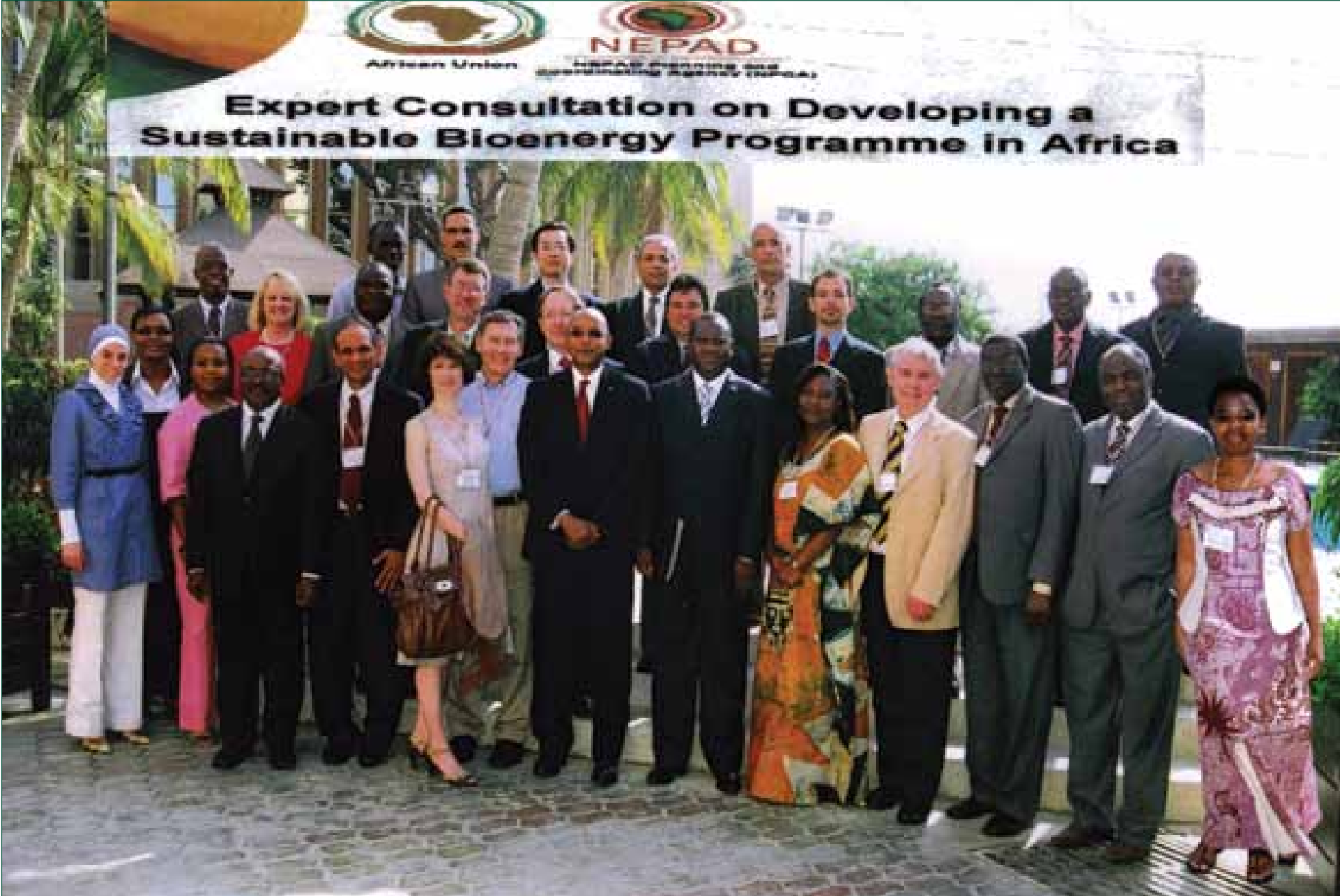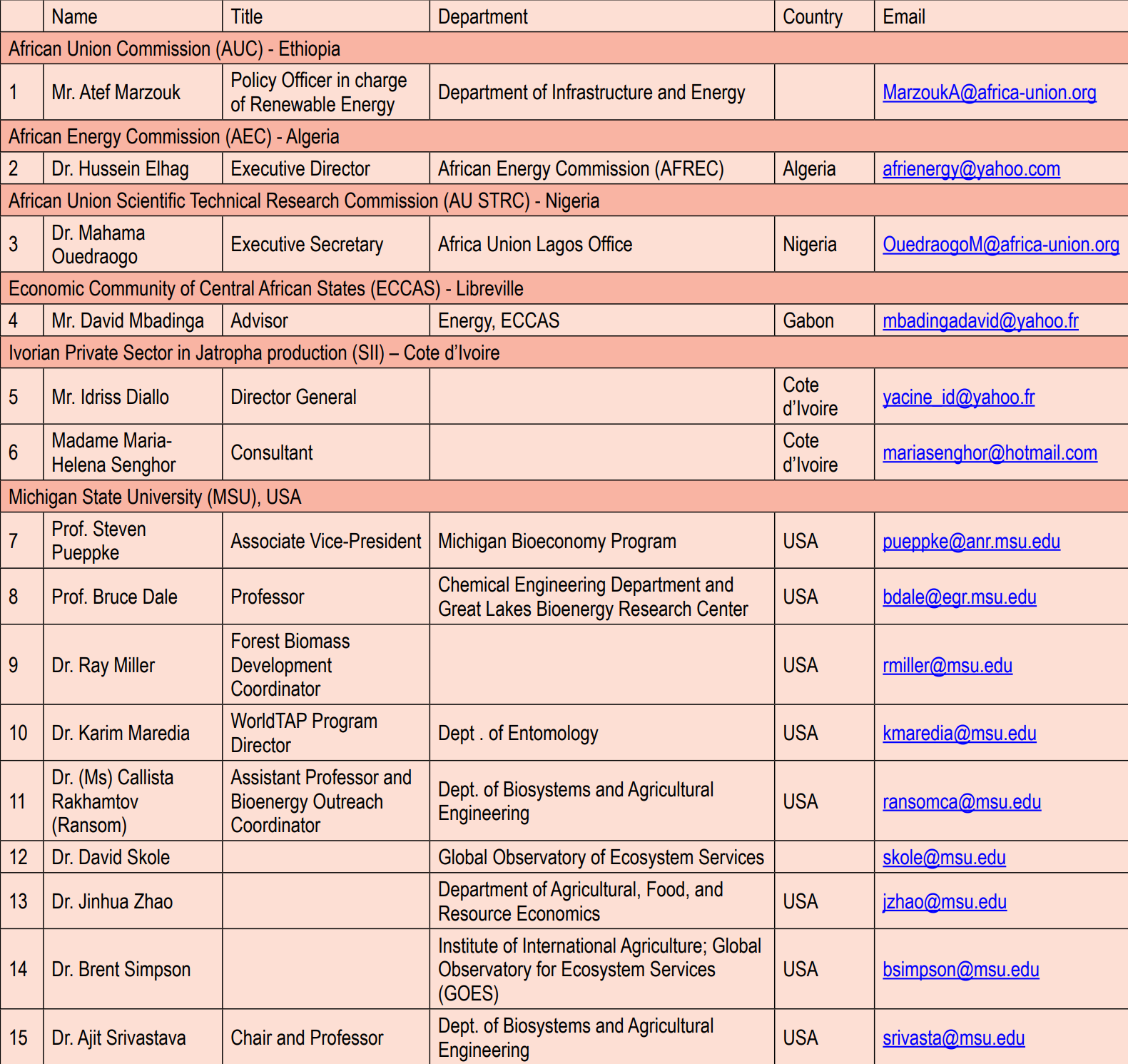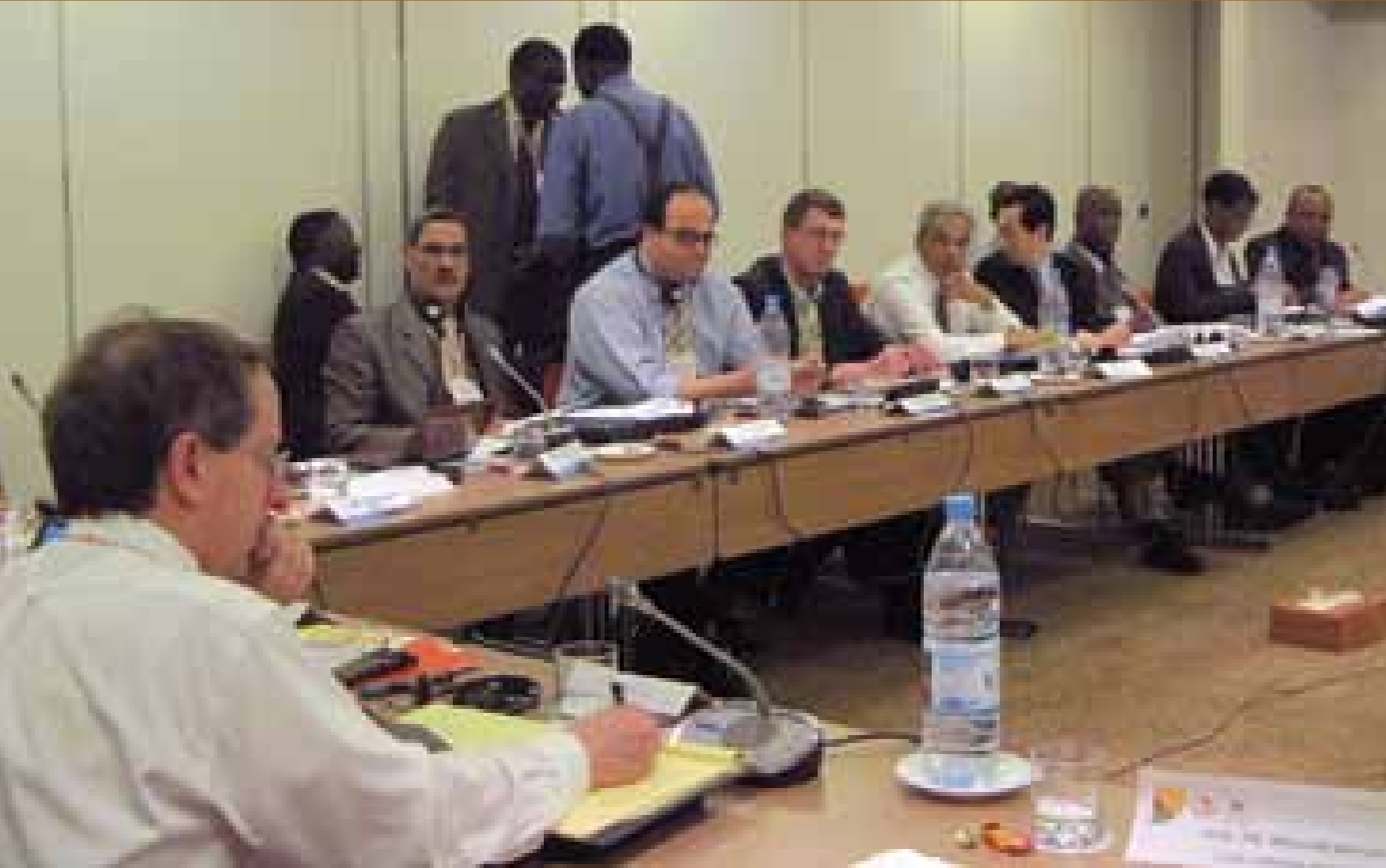
WorldTAP Policy Brief 02 – April 2010 NEPAD-MSU Expert Consultation on Developing a Sustainable Bioenergy Program in Africa
DOWNLOAD
WorldTAP Policy Brief 2 – April 2010 NEPAD-MSU Expert Consultation on Developing a Sustainable Bioenergy Program in Africa
April 12 - 14, 2010 Dakar, Senegal Edited by: Callista Rakhmatov (MSU), Karim Maredia (MSU), Aggrey Ambali (NEPAD), and Chimwemwe Chamdimba (NEPAD)
Many development activities and issues that are critical for Africa, such as soil degradation, restoration, access to potable water, mechanization, packag - ing and increased agricultural produc - tion are hindered by problems related to lack of energy and dependence on oil imports, which can in turn affect food security, so alternatives to oil must be developed. To address these issues, the NEPAD Agency Policy Alignment and Programme Development Director - ate convened a workshop to develop a sustainable bioenergy initiative. The NPCA Expert Consultation on Develop - ing a Sustainable Bioenergy Programme in Africa was held in Dakar, Senegal from April 12 to 14, 2010. It opened with over - views of several organizations’ programs on renewable energy, including AFREC, ECCAS, COMESA, UEMOA, AU, the Foundation, TERI (India) and Michigan State University (MSU). Sessions on carbon finance and production of jatro - pha followed. Then, NEPAD presented its concept note on Building a Sustain - able Bioenergy Industry in Africa, and breakout sessions discussed relevant programmatic areas. Finally, Key Recom - mendations and a Way Forward were presented.
I. Main Objectives
The main objectives of this expert con - sultation were to harmonize activities of various projects and organizations across the continent; to create a team with separate roles geared toward implementation; to develop a continental sustainable bioenergy policy framework that would be eventually adopted by the AU; to develop a regionalized framework to design and effectively implement sound projects that are feasible with current capacity (human resources, management and information); and to develop a concept note highlighting outputs that bring impacts.

II. Participants and Resource Faculty
The consultation brought together over 30 professionals from academia (Michigan State University, USA; University of Pretoria, South Africa), NGOs (United Nations Foundation), Economic Community of Central African States (ECCAS); Union Economique et Monétaire Ouest Africaine (UEMOA), Burkina Faso; The Energy and Resources Institute (TERI, India), the private sector (Ivorian Private Sector in Jatropha production, SII, Cote d’Ivoire), and government agencies (Ministry of Biofuels, Government of Senegal; African Union’s Scientific Technical and Research Commission - STRC; African Union Commission - AUC - Department of Infrastructure and Energy; African Energy Commission - AFREC; and NEPAD Agency - NPCA). A full list of participants is listed in Table 1.
III. Current Renewable Energy Landscape
Only 24 percent of the population of Africa has access to energy, and more than 70 percent of the population of Sub-Saharan Africa has no access to electricity. Between 70 to 80 percent of the energy on the continent comes from traditional energy sources (wood, charcoal, agricultural waste, etc.), and this amount is increasing.
Alternative energy sources are being explored and Africa has great potential. AFREC has a database of solar, wind, geothermal and hydropower. For hydropower, Africa has a lot of potential – it is second only to the Amazon region, but only 7 percent of the potential hydropower on the continent is being exploited. There is a database being developed for geothermal potential, and there are capacity building and training activities ongoing. Wind energy is also being explored, especially in coastal areas, as is solar.
Due to food vs. fuel concerns, cassava, grain and other food crops are not desirable biomass/biofuel crops. In Sudan, bioethanol produced as a byproduct of sugar production is exported to Europe. Sustainable bioenergy should be seen as only a part of the solution. It is necessary to get involved in secondgeneration technology.
A blueprint for action in biofuels should include the following pillars:
- Capacity building is needed across all projects and program designs and should address myths vs. facts, and engage consumers.
- Policy support to encourage investment. It is important to stick to timelines, identify champions, and develop long-term policies. The BioEnergy Evaluation Tool (BEET), a tool for policymakers, could be used.
- Engagement of private sector for financial support, market development and technology transfer. Small producers lack capital; a regional fund/hub for bioenergy activities (R&D, technology transfer, etc.) could be established.
IV. Issues and Roadblocks
Issues and roadblocks were identified in several areas.
Social and economic concerns
- Two extremes are represented: subsistence versus plantation and export.
- Food prices and energy prices are linked.
- Population is growing.
- Population is moving to cities creating urbanization where cities are growing and rural poverty increasing.
- Land tenure issues; farmers often do not own the land they farm.
- Scale of production (Brazil’s experience).
Environmental and technical/agricultural concerns
- Lack of access to inputs such as fertilizer and irrigation (and water availability).
- Climate change severely affects agriculture.
- Lack of or poor infrastructure.
- Deforestation from wood being used for cooking fuel.
- Sustainability.
Research and knowledge concerns
- Research and knowledge concerns.
- - Referenced reports relied on secondary data/consultations.
- Culture is not helpful.
- Method and training of surveyors and manner of conducting is not helpful.
- Lack of transparency as some data is not available to the general public.
- There is a political dimension.
- Data is expensive to collect.
- Gap of knowledge in how to best use wasteland instead of forest and arable land.
- Lack of trained human resources.
- Knowledge from research and development (R&D) not being spread.
Policy concerns
- Lack of integration and no common energy standards or policies.
- The debate about “Food vs Fuel” should more accurately be promoted as “Food AND Fuel.”
V. Opportunities and Suggestions
The issues, roadblocks and other concerns discussed provided a way to suggest some opportunities to handle and solve these concerns.
For social and economic concerns, it was noted that a regional biomass energy program would get the population involved in energy accessibility and poverty reduction by providing employment opportunities and encouraging entrepreneurship, especially among women. Enabling countries to participate in carbon markets would reward conservation promoters. In terms of financing, programs would need to be developed that would be bankable; establishing a regional biofuel market was discussed as an option.
To address technological concerns, the idea of biorefineries was discussed. Biorefineries process ligno-biomass (cotton, rice, cashew nuts, etc.) and other feedstocks for biofuel products such as bioethanol and bio-char. They would also add value, at least 60 percent more, by producing products and co-products such as fiber and chemicals. These biorefineries could be connected with existing power grids. The need for Africanization of technologies, knowledge base and human resources was stressed. Also, the group realizes that biorefineries are a long-term solution and short- and mid- term solutions such as possibly hydropower must be developed.
A need for more information, research, education, training and capacity building was clear. Different types of information gathering are required.
Demand
There is a central need for a study of energy demand. What is the demand on the continent, and for what types of energy sources? Is there a need for a substitute for fossil fuels and if so, which ones? An analysis of the demand for specific energy needs and opportunities is required. This assessment can determine what technologies and research and development (R&D) are needed.
Data
There were several suggestions to address the concern about lack of reliable data.
- Assess what has been done so far to address the lack of data. Brainstorm what needs to be done to solve the issue of lack of data, and ways to build systems to collect and track this data.
- Consider replicating the UEMOA study in other regions in Africa and scale up. The approach should be modified to reduce uncertainty, use sound national studies and integrate with activities on the ground. Sound data could be used to make the best possible diagnosis and form a realistic basis for decision-making.
- Harmonize methodologies and approaches (surveys). Develop a procedure to catalog kinds of crops or feedstocks for biofuels/bioenergy country by country. One suggestion was to explore the experiences of different countries that have done similar studies and have conditions similar to the corresponding African country, and replicate the study in that country.
- Develop an integrated database of statistics and other information: agricultural statistics, biomass statistics, current resources (arable land, infrastructure, people, human resources, inputs), etc. For example, it would be useful to know if a tract of arable land is serviced by rail or road, or neither. It was noted that FAO collects such data. Forest deforestation should also be tracked.
- A central (bio)energy information system should be established, where information on current bioenergy industry and activities, including research, is collected. At the time of the meeting, this was about 50 percent accomplished.
Until this database is established and information collected, there is really no way to know the long-term capacity of any country.
Education, Training and Capacity Building One suggestion was to create a regional database of training programs to identify which institutions do what, and when, and develop a regional center of training with a unified vision. In order to avoid redundancy and overlap, the need for synergy, information sharing, harmonization, coordination and participation was recognized.
Capacity development should be done at the subregional and national levels. Training and capacity building in regulations, building the chain from farm to pump, and status of biofuel resources were identified as needs. To provide this training, it was suggested that African universities partner to create a comprehensive program. As a first step, a continental seminar or conference should take place to identify providers such as universities, centers and governments.
Policy Concerns
To address policy concerns, it was suggested that the relevant stakeholders come together to develop a comprehensive, integrated bioenergy development policy that engages all sectors, including the entire energy sector. This policy should remove the barrier between food and biofuel decisions and be linked with broader development goals for the continent. It should address forest management and land use issues.
The policy should clarify bioenergy and development goals. How much should be produced and by when? Rural development or export or both? For example, land is being rented to foreign companies for biofuel production (sugarcane and ethanol), but the ethanol is being exported. It is unclear if this is the best use of the land, and if the country and people are being adequately compensated by the foreign companies. With a policy in place for such situations, negotiations with foreign companies can promote win-win solutions. Policymakers should engage experts for advice when creating long-term policies to avoid bad decision-making caused by short-term pressures.
The policy should contain the following elements:
- Goals
- Capacity development
- Technology transfer
- Finance
- Market development process
- Land use
- Enforcement
In developing this policy, the different policies present in different countries should be considered and there should be an attempt to harmonize them. Norms and standards should be agreed upon. There may be regional, cultural and political differences on various issues, and these need to be addressed in a sensitive manner. Problem-solving for these types of differences should be brainstormed. Regional differences could also be the result of differing strengths and weaknesses. Poles of strength and focal points for various components (e.g., natural resources, education, infrastructure, feedstocks) should be identified and strengthened, and a network between them should be established so that they are not working in isolation but in partnerships. Africa should also not isolate itself from other continents or regions. There are already a number of partnerships in place with India, China, Turkey, Brazil, the United States of America, Canada and the European Union.
VI. Breakout Sessions
After the discussions, the following breakout sessions were decided for further discussion:
- Policy advocacy and institutions – database
- Education, training and capacity building
- Technology and tech transfer and environmental issues (driver, social issues as drivers)
- Financing and markets
VII. Key Recommendations
The following recommendations emerged from the Expert Consultations on Developing a Sustainable Bioenergy Program for Africa organized by the AU/ NEPAD Planning and Coordinating Agency in collaboration with Michigan State University and the United Nations Foundation. More than 20 stakeholders provided their input into the development of these recommendations in this expert consultation organized in Dakar, Senegal from April 12-14, 2010. The stakeholders recognized that there is great potential for bioenergy in Africa, and bioenergy can serve as a driver for agricultural and rural development, environmental sustainability, energy security and economic growth on the continent.
- Policy Framework. The stakeholders recognized the need for a policy for developing, utilizing and managing bioenergy to serve as a guidance document for policymakers and decisionmakers at national, regional and continental levels. Awareness of bioenergy issues should be created through advocacy programs. Policy frameworks also need to be developed at country and regional levels. Policies should also address intellectual property rights.
- Education, Training, Information and Capacity Building. Build indigenous capacity and critical mass in Africa to take advantage of emerging opportunities in bioenergy. The capacity building should encompass human resources, institutional capacity and infrastructure with information, knowledge, skills, tools and facilities. It should also strengthen African universities to offer bioenergy education for building the next generation of leaders in bioenergy and develop databases on current capacity through on the ground assessment and consultations.
- Building on existing capacity and prior progress. Using existing knowledge, expertise, facilities and resources in Africa and around the world, develop an Africa Bioenergy Knowledge and Innovation Network to serve as a resource on bioenergy. Using the new tools of Information and Communications Technology (ICTs,) develop a repository of bioenergy information that can be easily accessed by various stakeholders.
- Bioenergy research, innovations and technology transfer. Create national and regional centers of excellence that can take a value chain approach and utilize and work across a range of diverse bioenergy sources and biomass (grain-based, cellulosic, algae, etc.).
- Bioenergy Industry Development. The private sector is expected to be a major driver in the development and commercialization of bioenergy. There is a need for creating an enabling environment for biobusinesses, bio-enterprise and bio-entrepreneurship development.
- Multidisciplinary aspect of Bioenergy. Bioenergy is multidisciplinary in nature and should encompass all the relevant disciplines or areas across the value chain. A technology approach should be taken in identifying and developing appropriate technologies that are environmentally sound, socially acceptable and economically feasible and target both rural and urban communities.
- Marketing of bioenergy. Use sustainable mechanisms and programs for marketing bioenergy to rural and urban consumers as well as export markets.
- Financing mechanisms for bioenergy programs. Consider government and private sector investments; international climate change funds for bioenergy programs (post-Copenhagen); and provide support for long-term research goals.
- Partnerships. Catalyze partnerships among various stakeholders including South-south and Northsouth partnerships; international partnerships and linkages; avoid duplication and create synergy
- Integration. Bioenergy initiative must be integrated with other local, regional and continental initiatives on food security, energy security, natural resources management and climate change mitigation.
VIII. A Way Forward
The plan of action should include two major components: development of a policy framework and program activities.
In developing the policy framework, AU/NEPAD should work with Regional Economic Communities (RECs) in member states to enhance and strengthen bioenergy policies, not necessarily build fresh policies. Countries should write their own policies and NEPAD should provide guidance. AU/NEPAD and other structures (AFREC, RECs) can assist in taking the process forward through the technology and political system.
As policy is being developed, technology development, capacity building and scientific projects can be identified. It is important to allow science to develop together with policy (politics) and to allow science to influence policy.
In support for activities in the program areas (capacity building, technology development, establishing markets and financing), the AU Science and Technology Consolidated Plan of Action framework has already been developed. As many of the same issues have been identified at this conference, we should feel free to move on and identify programs that we can begin developing and implementing.
The main issues, activities and opportunities identified by this expert consultation were:
- Carbon finance
- Land management
- Bioenergy – food production
- Partnerships
- Co-location of local facilities
- Use of wasteland
Policy issues cut across all of these. Also, economic and environmental benefits of bioenergy in Africa are linked.
The first step in the development of a policy document is to compile a comprehensive database including information on resources, rural energy access and use, and physical infrastructure within the countries (grid, roads, pipelines, etc). The policy document should present data from the database and also include a contextualizing section that would move toward addressing the most pressing critical problems and socio-economic issues.
It is also important to keep the momentum by remaining in touch. A program email listserv will be developed for the participants.




 Print
Print Email
Email





